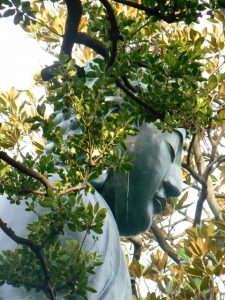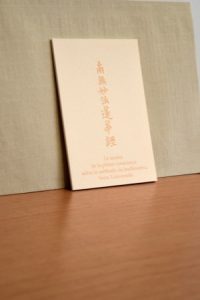
“You will all become Buddhas.”
Reiyukai is mainly based on the teaching of the Lotus Sutra of the Marvellous Dharma. In this text holding the ultimate teaching of the Buddha, the founder of Reiyukai, Kakutaro Kubo, discovered the key opening the door to the improvement of the world and to the resolution of human sufferings.
What is the key? It can be found in the role played by lay people, men and women alike, in the transmission and the realization of the Teaching. In the Lotus Sutra, the Buddha repeatedly insists on the presence and the function of lay people in the Sangha. Theirs is the role to replace the Buddha on earth after his extinction and to work at the building of peace in the world, the way the Buddha did.
The Threefold Lotus Sutra
The Lotus Sutra of the Wonderful Law
Ultimate teaching of Shakyamuni Buddha, the Lotus Sutra of the Wonderful Law (Myo Ho Renge Kyo) is one of the great classics of the world literature and one of the most influent text of Mahayana Buddhism. Today, the Lotus Sutra is still as essential as ever, driven by the force it contains. It counts more readers in the world it has ever had.
The disclosure of an unlimited potential common to all human beings
The Lotus Sutra is first and foremost an answer to all religions and to all the organized systems which declare “We are right and you are wrong.”
Indeed, the Lotus Sutra declares the universal liberation of everything that is alive. Its message is like a revolution; it keeps repeating “You will all become Buddhas.” This sutra stresses the fact that all living beings are fundamentally equal. The Lotus Sutra is intended for everyone, men and women, ignorant or learned people alike.
The universal message
The essential message of the Lotus Sutra is that all human beings can have access to the same enlightenment as the Buddha. The only reason for his coming to the earth is to reveal that very truth and to show them the way leading to Enlightenment. Only the bodhisattvas who cherish the wish for all human beings to reach Enlightenment and who guide them on this path, in keeping with the Buddha’s example and task, will end up reaching this supreme Enlightenment. The main theme of the Sutra – which constitutes its framework – is therefore the teaching of the bodhisattva’s’ practice. .
The subtle power of the Sutra
The basic principle of the Great Vehicle Buddhism is that every sentient being has the potential to reach the highest state of existence. The first role allotted to any sutra of the Great Vehicle is to bring out in its reader the universal conscience of change. In this regard its dynamism and its universal scope make the Lotus Sutra extraordinary. It expresses the Buddha’s dearest wish to enable others to reach the same state of consciousness he achieved. It both conveys the message and the ways to accomplish what is written. That is to say that at the very moment when it expresses the Buddha’s deepest wish, it shows us the path we should follow i.e. sharing the Teaching.
The “masters of the Dharma”
Thus, this Sutra suggests a wide conception of what a boddhistava is, the one of the “master of the Dharma”. The “Masters of the Dharma” as described in chapter X are the “ambassadors of the Tathagata”: they are “sent by the Buddha and carry on with his task”. Their merits on the path towards awakening are largely listed in chapter XX. Transmitting the Dharma to others will purify their sense organs and enable them to acquire perfect senses. So, thanks to their purified senses, they will fathom all the teachings and understand all the phenomena. They will not have achieved a state of perfect purity but will be devoid of fear; experiencing blissful conditions “they will be able to clarify and explain the Dharma thanks to thousands of myriads of kotis of skilful words”.
A living transmission
Thus these bodhisattvas play an essential role in the living transmission of the Teaching. This responsibility directly lies on their aspiration, their generosity and their determination to carry out their own transformation. The Lotus Sutra encourages us to accomplish this action while stressing a better knowledge of the reality in its human and enlightened dimensions. The Lotus Sutra is humanistic in the sense that human actions are placed at the core of the practice. These actions aim at the improvement in humanity and the transformation of human beings’ life conditions even if they depend on the progress in the achievement of an awakened mind. Human beings are invited to share the teaching of the Lotus Sutra with others and thus to relieve every single human life of misery and suffering. It is man’s role to improve this world and to make it a place where peace and harmony will prevail.

The door to the heart
The Lotus Sutra is not like any other book and cannot be read as such. It must be read with the “inner eye” and does not aim at transmitting its readers an intellectual knowledge but at opening their hearts so that they will be able to experiment and discover the truth by themselves. That is why the devotees prefer to read it aloud, letting words echo in their hearts.
How to transmit
It is one of the most important texts of the Great Vehicle Buddhism but it is also the longest with the twenty-eight chapters of the Chinese version. These chapters are often composed in the following ways: the Buddha expounds a teaching. Afterwards, members of the Assembly, great followers, gathered in order to listen to the Buddha’s preaching ask questions or share how they have experienced this teaching so as to make it more easily understood. This teaching is then illustrated with a parable staging characters and situations that make this teaching more concrete. The introduction of these parables indicates the wish that each devotee, whatever their levels of education should be able to understand a deep teaching presented by the Buddha himself as “difficult to grasp”.
Potential Buddhas
Most devotees tend to believe there is a great difference between them and the Buddha they see as an ideal being. In other words, they feel there is a gap between the Buddha and them. This feeling lasts as long as they remain shut to the teaching expounded in the Lotus Sutra, but as soon as they take refuge in the teaching of this Sutra this feeling of estrangement vanishes. The Lotus Sutra reveals the total absence of a gap. All the Sutras of the Great Vehicle convey this idea but the Lotus Sutra states even more clearly that all human beings can follow the way of the bodhisattvas and have the potential to become buddhas.
A dynamic transformation
While this bodhisattva aspires to the Buddha’s perfect and supreme enlightenment, he sincerely wishes to improve his situation as well as the others’. By the very act of passing on the Sutra to someone else and of accompanying them, he consciously and heartily manages to penetrate the reality of the karmic world and also discovers the one of the spiritual world. He sharpens his own spirit of research and little by little realizes the nature and the meaning of the Teaching. He becomes conscious of his own reality as well as of the others’ therefore; being linked to the world of the Awakened he becomes able to remedy his imperfections and to reform his behaviour. He develops qualities and gradually builds up a wise and benevolent humanity. By offering this Teaching to others he also enables them to get free thanks to the same practice. Together they purify the world. It is therefore crucial not to see a bodhisattva as someone cut off from reality.
Legendary models
The last chapters of the Sutra are mainly stories about great Bodhisattvas, such as Avalokitesvara in chapter XXV. The main function of these stories is, once more, to enable readers to become aware that the most important thing is the wish to progress on the right path. Following the bodhisattvas’ example, the impulse to act will inspire each one the mode of action best-suited to their progression on the path.
It is not sufficient to read this sutra; it is a book that must accompany us and pervade our life so that it will end up being utterly transformed.
The Innumerable Meanings Sutra
In the Threefold Lotus Sutra, the Innumerable Meanings Sutra comes before the Lotus Sutra. Even if it has always been placed before the Lotus Sutra, history does not reveal if this Sutra must be considered a prologue to the Lotus Sutra. The order of the three sutras of the Trilogy – the order used today – as well as the connection between them were established by Chi-i (538-597), founder of the T’ien-tai buddhist school (called Tendai in Japanese).
Historically, few elements are known about the Innumerable Meanings Sutra.
When reading this Sutra, we realize it is a complement to the Lotus Sutra. Many consider it prepares the reader to hearing the wider teaching of the Lotus Sutra. It is often said that it exemplifies its goal and gives access to its meaning.
The Sutra of Meditation on Bodhisattva Universal Virtue

«World-Honoured One! After the extinction of the Tathagata, how will human beings develop their aspiration to become bodhisattvas, put the universal sutras of the Great Vehicle into practice and correctly reflect on the sphere of the ultimate truth of reality? How will they manage to keep their aspiration to reach ultimate Enlightenment? How will they manage to purify their sense organs and get rid of their errors without extinguishing their illusory passions and renouncing their desires? How will human beings manage, without renouncing their five desires, to see the reality beyond illusions with the very eyes they have received at birth from their parents?”
Such are the questions whose answers are to be found in this sutra. The greatest part of this sutra deals with the different practices accomplished by a devotee in order to purify his six sense organs one after the other. It explains how to awaken and keep the determination of a bodhisattva thanks to the power gained by reciting the Sutra of the Great Vehicle. Next it explains that karmas will be solved and the sufferings resulting from erroneous deeds will disappear provided their authors recite the Sutra of the Great Vehicle, meditate on its teaching and accomplish praiseworthy deeds.
The Sutra of Meditation on Bodhisattva Universal Virtue is the only sutra that explains the Buddhist concept of the purification of the six senses according to the Great Vehicle, an essential concept in the practice of bodhisattva. The essence of this purification lies in the process of the purification and transformation it generates. When we purify our six senses and learn how to control them, we become able to perceive the ways our sense organs, blocked as they are, deceive us and lead us in the wrong directions. By teaching us how to purify our senses, the Sutra shows us the means to see, feel, taste, hear and understand the reality as it is.
In the first part, the Sutra explains that it is possible to grasp the ultimate truth of reality by getting rid of what blocks our consciousness, yet without renouncing our desires. The fact that this sutra encourages its disciples to try to purify their sense organs is an additional reason to think it is most particularly designed for lay devotees.
If we compare the two basic attitudes expounded in the Innumerable Meanings Sutra and the Sutra of Meditation on Bodhisattva Universal Virtue, we can notice that one says “it shall arouse …” whereas the other says “you will do it yourself…”. That is what makes it plausible to assume that the Innumerable Meanings Sutra is a kind of prologue or preparation to the more complex Lotus Sutra. The place and the meaning of the Sutra of Meditation on Bodhisattva Universal Virtue become clear after the content of the Lotus Sutra has been grasped. In fact it introduces the way one should practice, in other words how to make the theories contained in the Lotus Sutra lively and concrete. It is probably the reason why it comes as the epilogue of the Trilogy.
Photographie : Jean-Benoît Dupont (haut)
